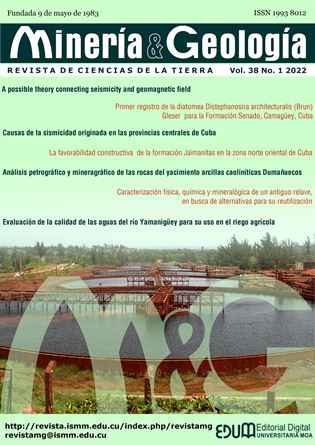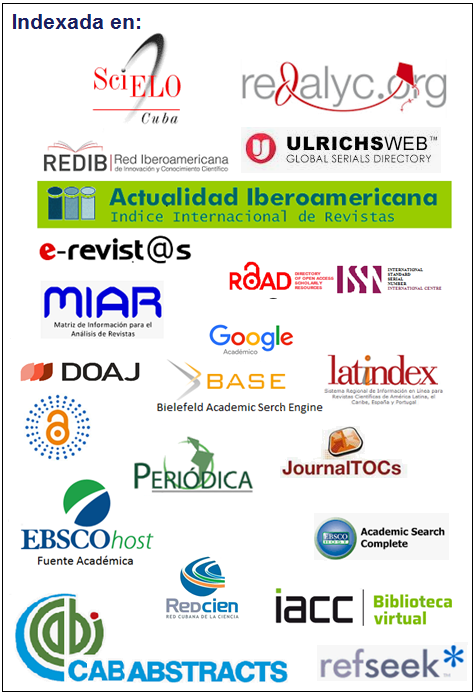Una posible teoría que relaciona sismicidad y campo geomagnético
Keywords:
campo geomagnético, terremotos, circuito eléctrico, atmósfera global, respuesta conductiva de la tierra, distribución de terremotos.Abstract
Se presenta una posible teoría que relaciona el campo geomagnético y los terremotos. Se realizaron varias distribuciones horarias de terremotos para diferentes partes del mundo para explicar por qué la distribución horaria en forma de bahía es clara para algunas zonas, pero no para otras. En este sentido, se observó que los terremotos ubicados en zonas intertropicales revelan una distribución horaria en forma de bahía, por el contrario esta forma de distribución no se observa para los terremotos fuera de los trópicos. La respuesta se plantea en función de la orientación del flujo magnético. El ángulo entre la dirección del campo magnético y la superficie de la Tierra es casi paralelo en el ecuador y ortogonal en los polos. Por consiguiente, considerando la ley de fuerza de Laplace, la fuerza experimentada en el conductor eléctrico, en presencia de campo magnético, es máxima cuando el ángulo entre la dirección del campo magnético y el conductor eléctrico es de 900. Aquí, el conductor eléctrico se encuentra en el circuito eléctrico atmosférico global, donde la corriente eléctrica fluye ortogonalmente a la superficie de la Tierra. Las zonas intertropicales tienen ángulos entre el vector de flujo magnético y el conductor eléctrico más cercanos a los 900 que las latitudes medias y las áreas polares. La distribución horaria de los terremotos está modelada por el potencial eléctrico con fluctuación temporal del circuito eléctrico atmosférico global, que es más significativo en las zonas intertropicales. El efecto de la electricidad sobre los terremotos se basa en el fenómeno piezoeléctrico inverso.Downloads
References
Duma, G. and Vilardo, G. 1998. Seismicity Cycles in the Mt. Vesuvius Area and their Relation to Solar Flux and the Variations of the Earth’s Magnetic Field. Phys. Chem. Earth, 23(9-10): 927-931. https://doi.org/10.1016/S0079-1946(98)00121-9
Eccles, D., Sammonds, P.R. and Clint, O.C. 2005. Laboratory studies of electrical potential during rock failure. International Journal of Rock Mechanics & Mining Sciences, 42: 933-949. https://doi.org/10.1016/j.ijrmms.2005.05.018
Fujii, I. and Schultz, A. 2002. The 3D electromagnetic response of the Earth to ring current and auroral oval excitation. Geophys. J. Int., 151: 689–709. https://doi.org/10.1046/j.1365-246X.2002.01775.x
Gao, Y., Chen, X., Hu, H., Wen, J., Tang, J. and Fang, G. 2014. Induced electromagnetic field by seismic waves in Earth´s magnetic field. J. Geophys. Res. Solid Earth, 119 :5651-5685. https://doi.org/10.1002/2014JB010962
Johnston, M.J.S. 2002. Electromagnetic Fields Generated by Earthquakes. In: Lee, W., Jennings, P., Kisslinger, C., Kanamori, H., (Eds.), International Handbook of Earthquake and Engineering Seismology Part A Vol. 81, Elsevier, San Diego, pp. 621-635. https://doi.org/10.1016/S0074-6142(02)80241-8
Klein, F.W. 1976. Earthquake Swarms and the Semidiurnal Solid Earth Tide. Geophys. J. R. astr. Soc., 45: 245-295. https://doi.org/10.1111/j.1365-246X.1976.tb00326.x
Lei, Y., Jiao, L. and Chen, H. 2018. Possible correlation between the vertical component of lithospheric magnetic field and continental seismicity. Earth, Planets and Space, 70(179):1-19. https://doi.org/10.1186/s40623-018-0949-7
Marchitelli, V., Harabaglia, P., Troise, C. and De Natale, G. 2020. On the correlation between solar activity and large earthquake worldwide. Scientific Reports 10 (11495). https://doi.org/10.1038/s41598-020-67860-3
Moreno, B. and Calais, E. 2021. Evidence of correlation between high frequency geomagnetic variations and seismicity in the Caribbean. Open Journal of Earthquake Research, 10:30-41. https://doi.org/10.4236/ojer.2021.102003
Rycroft, M.J., Israelsson, S. and Price, C. 2000. The global atmospheric electric circuit, solar activity and climate change. Journal of Atmospheric and Solar-Terrestrial Physics, 62 (17-18):1563-1576. https://doi.org/10.1016/S1364-6826(00)00112-7
Sorokin, V.M., Chmyrev, V.M. and Hayakawa, M. 2020. A Review on Electrodynamic Influence of Atmospheric Processes to the Ionosphere. Open Journal of Earthquake Research, 9:113-141. https://doi.org/10.4236/ojer.2020.92008
Urata, N., Duma,G. and Freund, F. 2018. Geomagnetic Kp Index and Earthquakes. Open Journal of Earthquake Research, 7:39-52. https://doi.org/10.4236/ojer.2018.71003
Williams, E.R. 2009. The global electrical circuit: A review. Atmospheric Research, 91:140-152. http://dx.doi.org/10.1016/j.atmosres.2008.05.018
Published
How to Cite
Issue
Section
Copyright (c) 2022 Bladimir Moreno Toirán

This work is licensed under a Creative Commons Attribution-NonCommercial 4.0 International License.
- Authors retain copyright and guaranteeing the right magazine to be the first publication of the work as licensed under a Creative Commons Attribution-NonCommercial that allows others to share the work with an acknowledgment of the work's authorship and initial publication in this journal.
- Authors may establish separate supplemental agreements for the exclusive distribution version of the work published in the journal (eg, place it in an institutional repository or publish it in a book), with an acknowledgment of its initial publication in this journal.
- Authors are allowed and recommended to disseminate their work through the Internet (e.g., in institutional telematic archives or on their websites) before and during the submission process, which can produce interesting exchanges and increase citations of the published work. (See The effect of open access)




